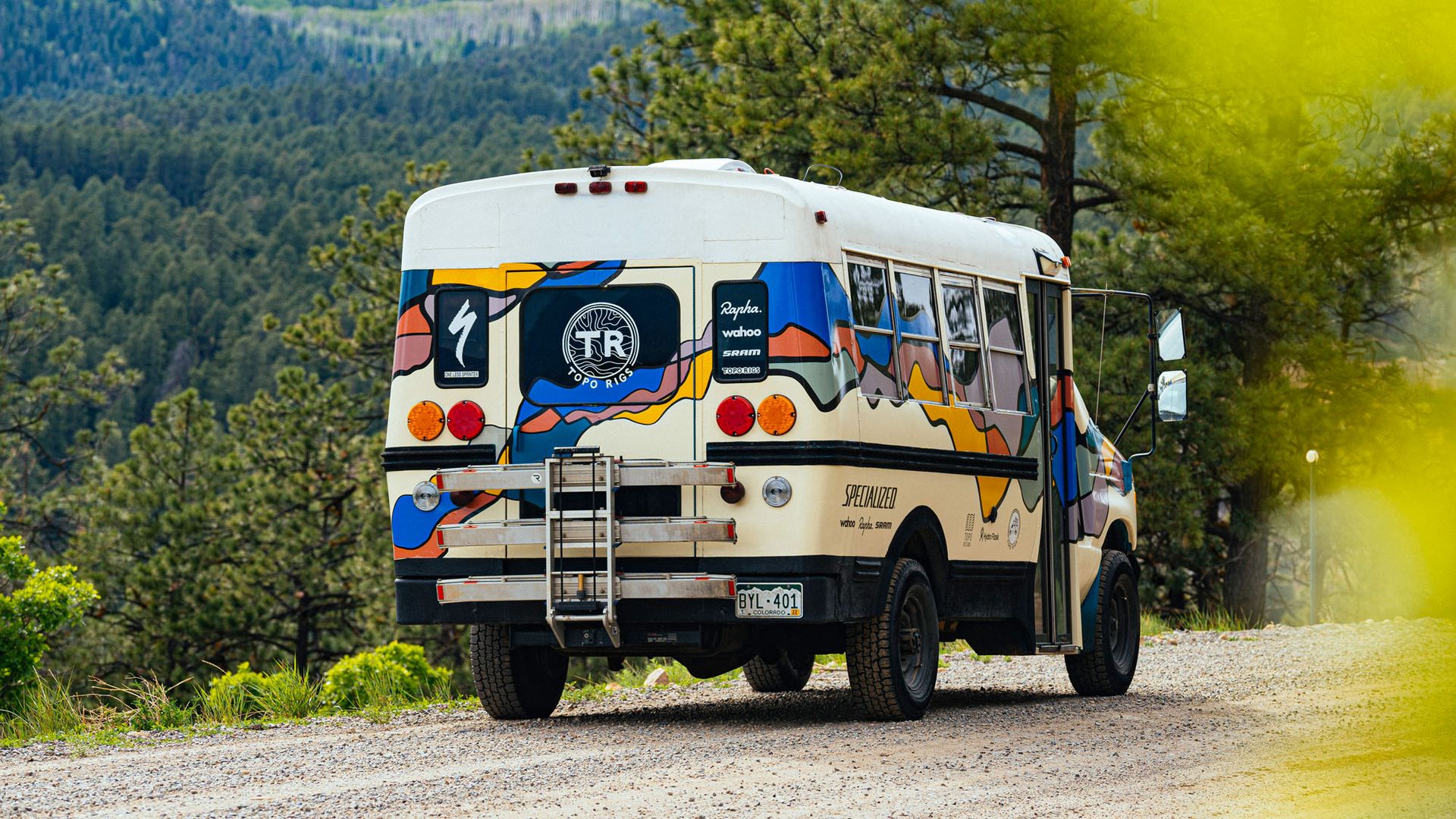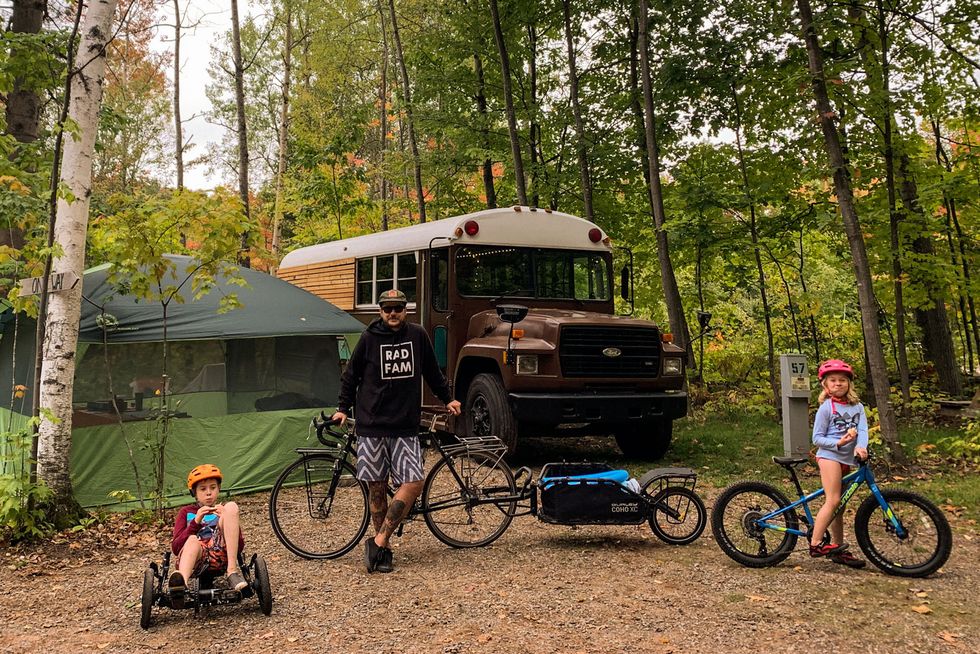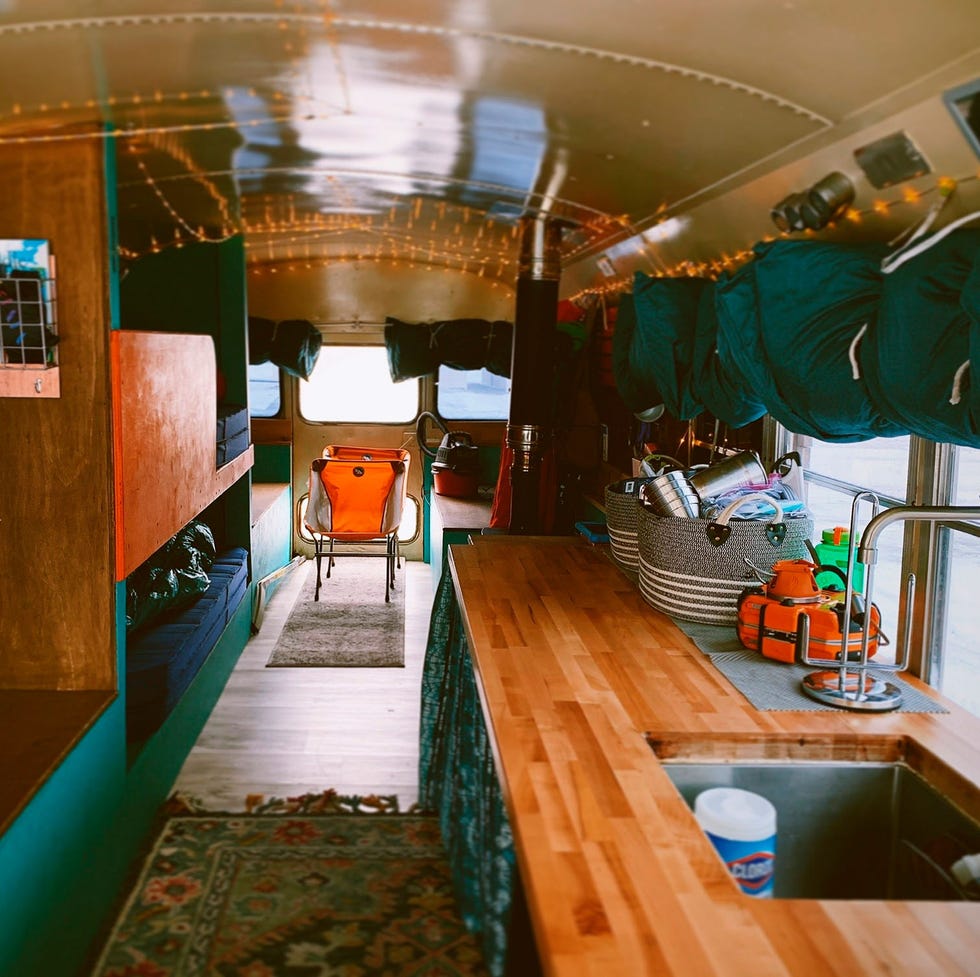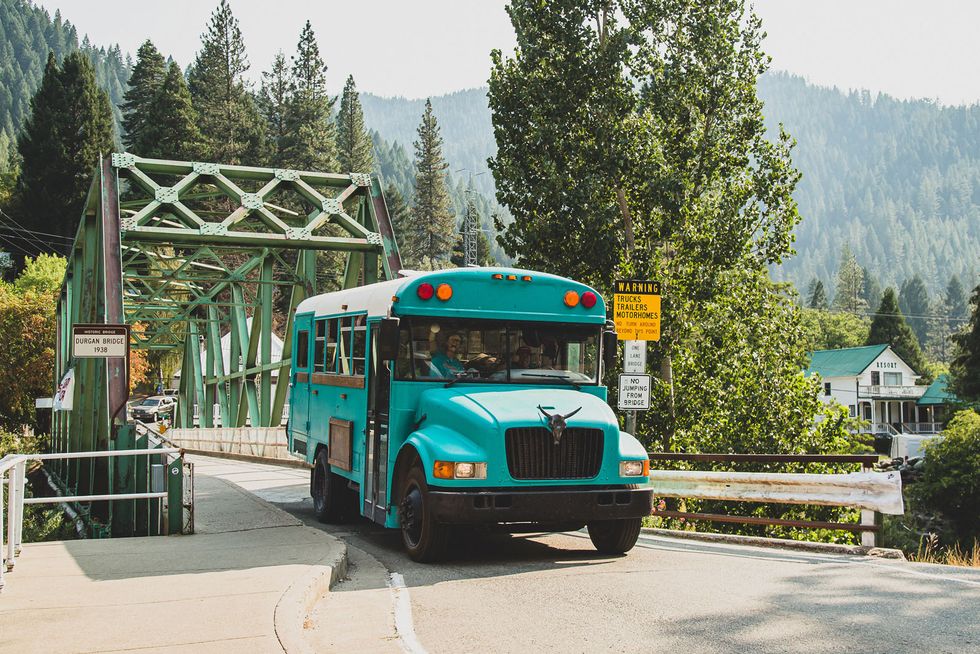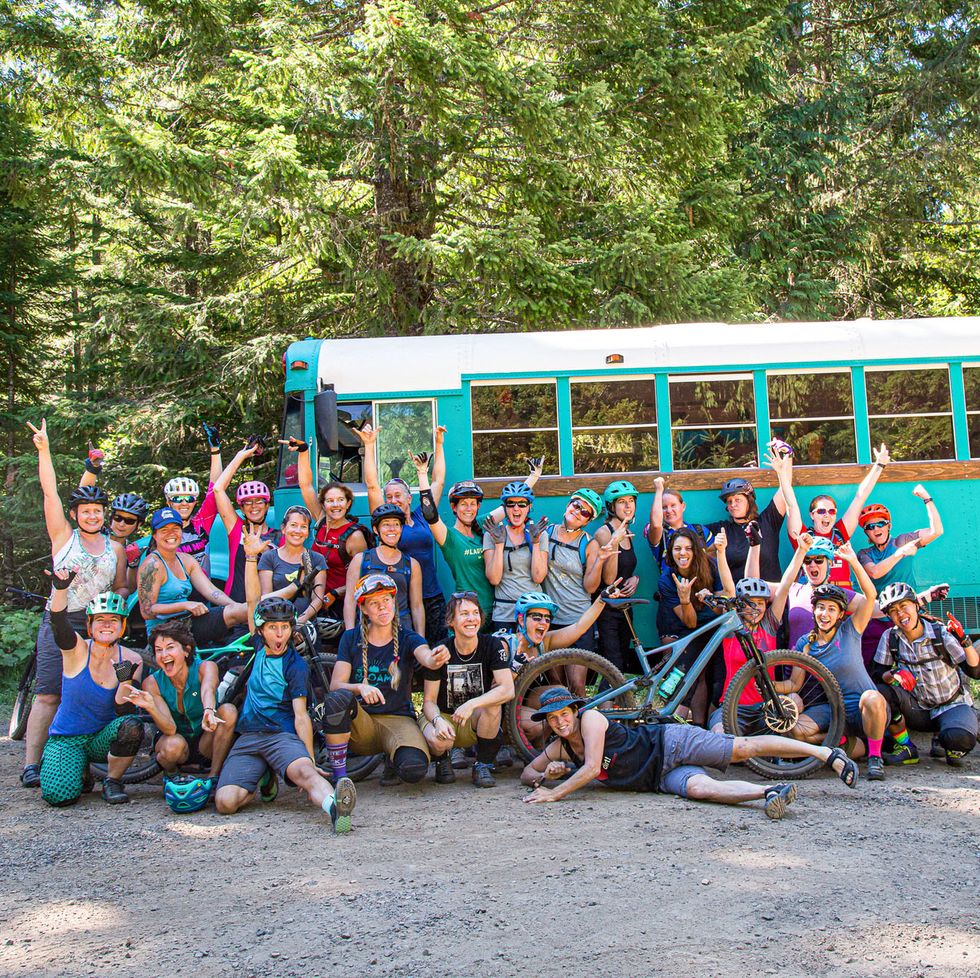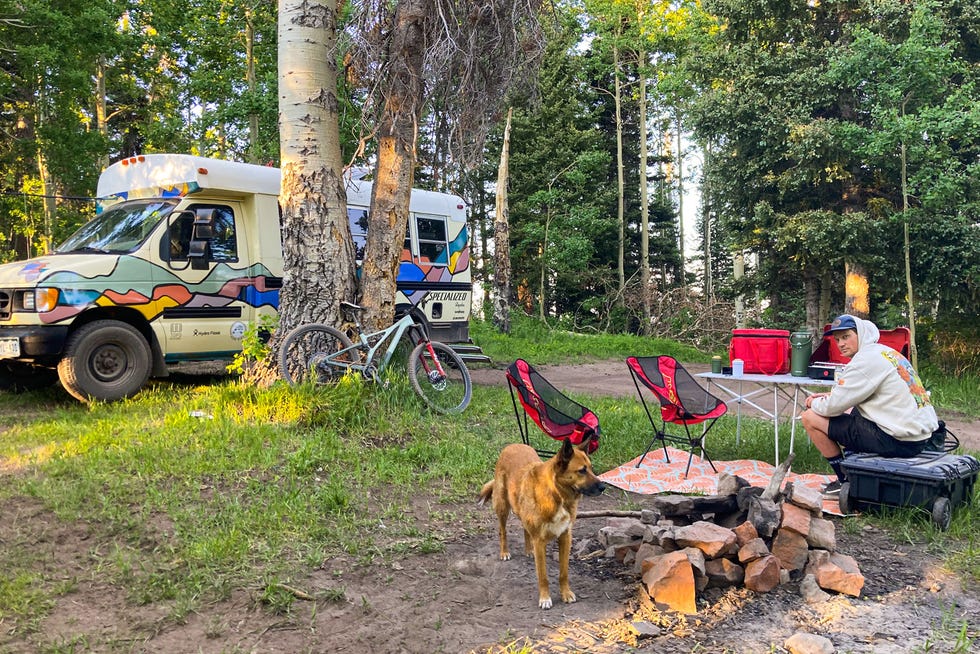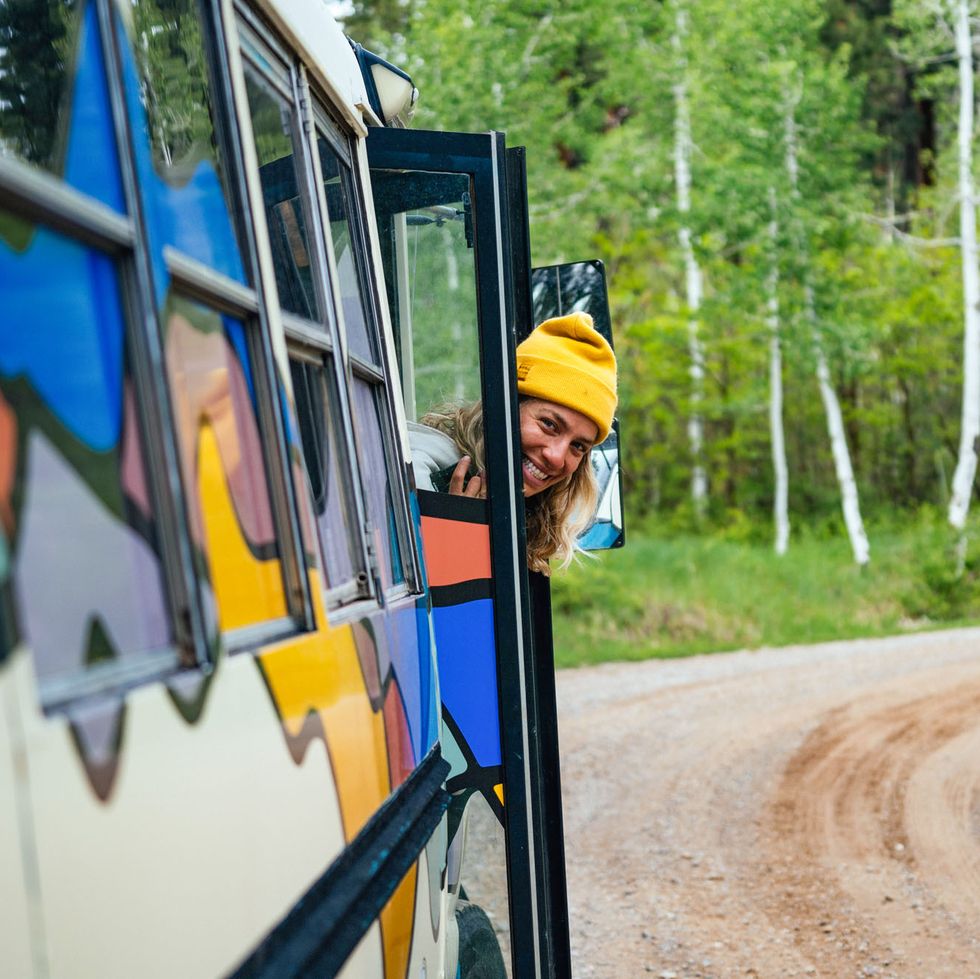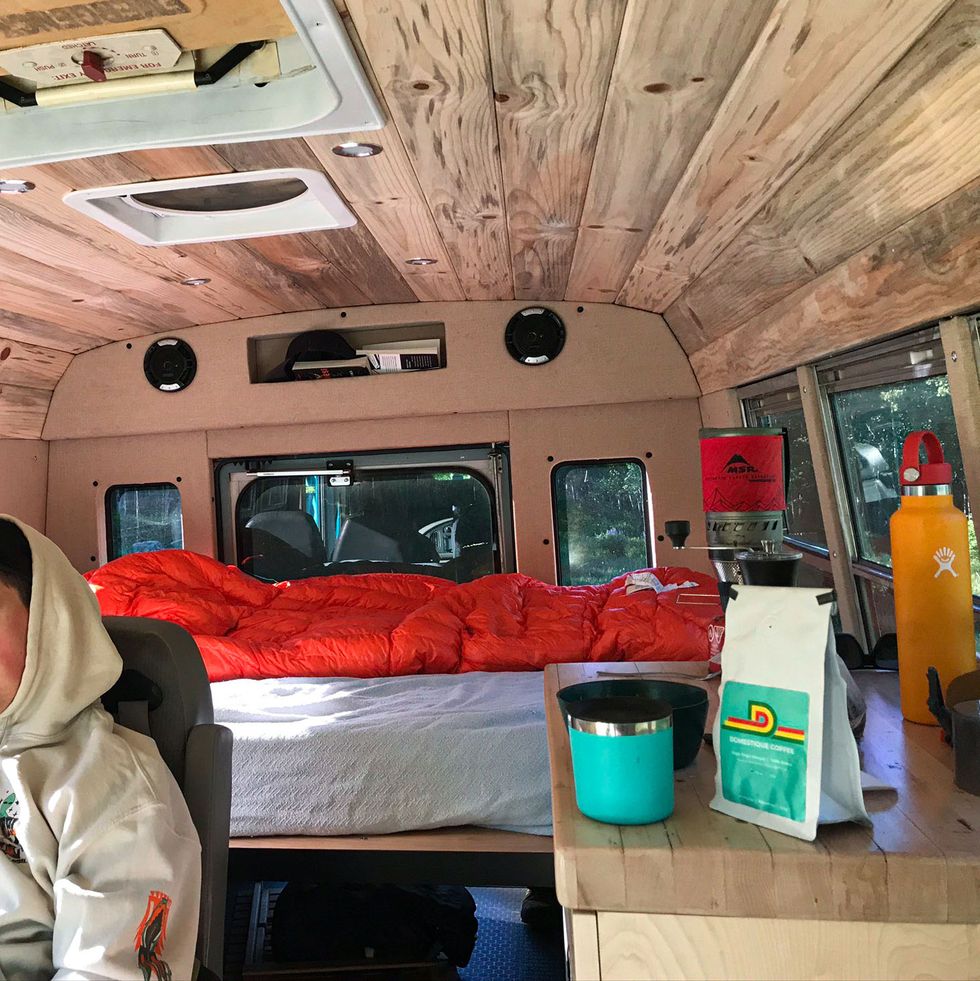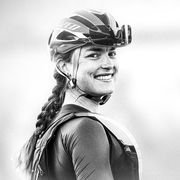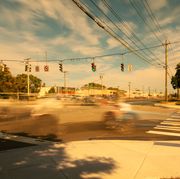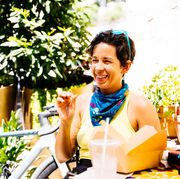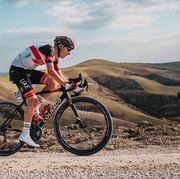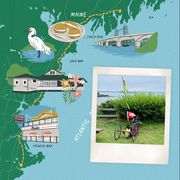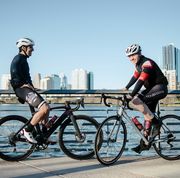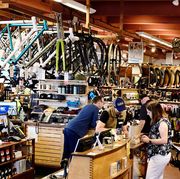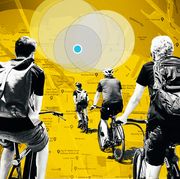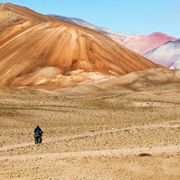John Curtis had wanted a skoolie for almost two decades. “But the truth was that I wasn’t responsible or mechanically inclined enough for such an adventure,” says Curtis, now 35. And so until 2019, when he and his wife, Bre, were finally ready to buy a school bus and turn it into a tiny house on wheels, the adventure filmmakers endured a crowded van loaded with “stinky dudes” and a pull-behind camper. An old school bus, redesigned for their exact needs—racks for bikes and beds for seven—cost them thousands less than an RV (which also wasn’t rugged enough for John) and offered more space than a #vanlife conversion. Their skoolie became the perfect vehicle for the Curtises and their two kids to “go off grid and hunt down trails.”
Cheap, rugged, and reliable, more and more skoolies are appearing at trailheads and bike races. They’re ideal adventure vehicles for cyclists to travel to and explore places way, way off the beaten path. Here’s how the Curtises and two other skoolie owners live their best cycling lives with the help of a custom bus.
“We call it our adventure rig,” says Bre Curtis, 36, of the skoolie she and her family use for their bike adventures. Some trips last a few hours, others a month or longer. While the Curtises have a home in northwest lower Michigan, the family—Bre, John, and two homeschooled kids, plus a 140-pound dog—live in the bus on and off for about three months a year. “My parents think we’re crazy,” says John. “They’re, like, ‘you’re living in a 19-foot-long space, isn’t Bre sick of you?’ You know, sometimes it might get a little tense, but nothing can outweigh the value of the experience.”
The Curtis family, known as the Rad Fam on Instagram, uses their skoolie to find off-grid cycling adventures all over the U.S., though they admit that the Michigan trails are among their favorites.
Bre and John bought their bus, a 1988 Ford B-700 with only 38,000 miles, off Craigslist for $1,500. (It’s not unusual to see buses listed for up to $20,000 on the West Coast and around the Rocky Mountains.) The bus was someone else’s abandoned project and came with the bolted-down seats already removed. They say they spent about $22,000 on mechanical upgrades and the build-out of the 146-square-foot interior space.
Skoolies can be outfitted with showers (indoor or outdoor), toilets, beds, and full working kitchens. The Curtises designed theirs with two priorities in mind: beds and bikes. “The goal is arrive, get out of the bus, and then go do your stuff, come back, make dinner, and hang out,” says John, who with Bre runs NMLifestyle, an adventure film company.
The bus sleeps seven, with two permanently fixed bunk beds and a front bench area that doubles as a bunk. In the back, Bre and John’s bed is two separate benches that they convert for sleeping by laying out slats cut to fill the gap between the benches.
The Curtises store bikes on the roof and inside. On the back of the bus, a permanent roof access ladder leads to a 10x10 platform, and a pulley system hoists bikes up. Fastening the bikes to a Thule fork mount with front wheels off and seats lowered allows them to come in under the 13-foot clearance required for power lines and cables, says Bre. And ski straps, long pieces of thick Velcro with a rubber inner layer, secure the rear wheels. They say it takes only about four minutes to take the bikes on or off.
As they prefer more space for sleeping and storage—they travel with a small bike shop that includes a rack, tools, pumps, hydraulic fluids, backup brake pads, grips, and pedals stowed away—the rig has no toilet or shower.
Four solar panels generate up to 800 watts from the roof, letting the bus go completely off grid for as long as the Curtises have food and water. “So when we go down into Moab and boondock out in the desert,” says John, “as long as there’s sun, our solar system will run forever.”
“The family is not very planned-out people,” he adds. “We’re more of the roll-with-it types.” On any given morning, if someone’s itching for adventure, the family will vote on the next trip. If there’s consensus, they hit the road. After a recent trip to Michigan’s Upper Peninsula for a week of leaf-peeping and a vote to return home, John says, “we were parked at the trailhead of Glacial Hills two days later, making SpaghettiOs in the parking lot and ripping in the woods. We just keep rolling like that.”
Still, fuel use is a factor in planning every trip. If the wind is behind the Curtises, they get about 9 miles per gallon. Into the wind, it’s as low as 6.5 mpg. That trip to Moab will cost nearly $900 one way. “It sounds pricey, but the savings come into play when you look at the cost of lodging. We can stay on BLM [Bureau of Land Management] land free of charge for weeks on end, and that’s a huge saving when hotels are $120 a night,” says John.
“It’s amazing being able to wake the kids and say, ‘Hey, the sun’s coming up and I want to ride to the top of the mountain with you and see the sun come up,’” John says. “And now you’ve created this experience for your children.
Ash and Andi Zolton, owners of Roam Events, designed their skoolie not only for themselves but also to heighten the experiences of their clients. They founded Roam Events in 2016, which Andi, a bike mechanic and former bike racer, describes as “women-focused bike parties."Their company grew out of what they saw as “this need for women riders to go and experience a fun weekend with other female riders and getting all the good empowering juju that comes from that,” says Ash, who previously helped run events for Giant’s Liv Cycling. The idea was an immediate hit. Roam’s success meant Ash, 36, and Andi, 35, who married in 2020, needed to upgrade their adventure wagon, a Toyota Tacoma, almost immediately. “Everyone and their mom has a van, but like who rolls up to an event in a dope skoolie?” says Andi. “It’s always fun to see people’s reactions; like, two women popping out of this huge rig towing a 16-foot trailer.”They admit that they likely spent too much on the 2004 International 3000 they found in Florida on eBay for $10,000 (despite having 173,000 miles on it). They built it out with a carpenter friend for another $10,000, including pulling the seats and about 468 bolts out of the floor. “Andi looked like she was a coal miner every day coming out from underneath the bus,” says Ash. They also removed the hydraulic lift and closed off the back exit.After two months of work, they took off for their next event in “Nancy 1.0, a skeleton of a bus,” says Ash. Other than removing the seats and bolts, they’d only had time to paint the bus and put down a subfloor and flooring. Their bed was a wood desk they bought on Facebook Marketplace, six feet long and 32 inches deep, that they bolted to the floor and threw a mattress on top of. It doubled as a couch, and the drawers offered some storage space. They had one table and the rest of the bus was open space.
They learned a lot in that first year, including that their original concept of making the 102-square-foot skoolie a “do-it-all vehicle”—both a home and a shuttle vehicle for bikes—was a mistake. “We needed to separate church and state,” says Ash. So they decided to make Nancy their home, for a “sense of normalcy when we are on the road 24/7,” says Ash.
In renovating the bus into Nancy 2.0, they relegated the bikes, for the most part, to a six-bike Recon Rack system on the back. Because they need to transport as many as 22 bikes at a time for their events, they also hitch a 16-foot trailer to the back of the skoolie using a 20,000-pound receiver. With a 7.6 turbo diesel engine, “Nancy’s like a beast,” says Ash.
Four years into their skoolie life, Andi and Ash are now on redesign number three, or Nancy 3.0, which Andi calls “very Pinteresty.” A lofted bed in the back allows for additional storage (up to eight bikes, if needed) and caters to their “very low” lifestyle needs, says Ash. “We don’t need a shower every day, I don’t need to wash dishes and do a fancy dinner.” They have what they call their “camping box” at the ready, a plastic bin that holds their camp stove, pans, pots, plates, and anything else they need for cooking, as well as a table that drops down on the side of the bus to cook outside. “And we have an electric kettle, because coffee,” says Ash. For the most part, when they’re running events, the skoolie is their office. “We’re not necessarily boondocking very often,” says Ash.
During the height of the pandemic, unable to run their festivals, they drove their skoolie to their favorite trails for three months. “It was incredible to be able to just pack up the bus and kind of go where the wind took us,” says Ash. They hit Idaho, Montana, Oregon, and Washington.
Best place they have ever parked their skoolie “The whole Northwest Washington area, if we were to have to pinpoint our favorite places to ride. The Tiger Mountain trail system, which is just east of Seattle, and the Raging River trail system, which is in the same mountain range,” says Ash.
Ash and Andi Zolton’s Skoolie Tips for First-Timers
- Camp in your bus before committing to a complete build-out—that way you can figure out what you really need. “We learned over those first months how much storage we really needed and where we wanted things,” says Ash.
- “Angle grinders should immediately be purchased upon getting a school bus,” says Ash. The tool is essential for seat bolt and rivet removal. Complement it with a face shield and dust mask.
- YouTube is your skoolie renovation guide. Andi says their approach was to watch different videos for every project or problem, and then combine the methods to create one that worked for them.
- Budget your time. “Nancy 1.0 probably took around 300 hours, two or three solid weeks of the two of us doing almost nothing else,” says Andi. Nancy 2.0 was another 250 hours, while Nancy 3.0 only needed new cabinets.
Sarah Sturm, 31, is a professional gravel racer. She lives and trains full-time in Durango, Colorado, but travels to five to 10 races a year in her skoolie. Buying it in 2018, soon after signing her pro contract with Specialized, was life-changing, she says. “It really transformed my happiness. I didn’t even realize that’s what I needed until this past gravel season. My family gets to come along. I’ll bring my sister and her dog, or my mom or my boyfriend, Dylan Stucki. I’ve had the best season of my life.”
When Sturm bought the skoolie, a Ford E-350 turbo diesel, she didn’t expect that it would become her home away from home. “We pretty much use the bus anytime we go race, camp, or adventure,” says Sturm, who will often live in the bus a few weeks at a time over the summer. “Even though it would seem to be more of a pain in the ass than flying, it’s actually a lot more comforting and easier for me,” says Sturm. Knowing that she has the same comfortable bed waiting for her and a fridge stocked to her liking is super important when racing and traveling all the time, she adds. An independent pro athlete, Sturm says the decision to buy a skoolie was one part work, one part comfort, one part dog. She and Stucki recognized that they needed a vehicle for traveling and racing while bringing their dog, Norman. “We wanted something where we could go for a ride and then take Norman out, do a little Norman ride and leave him in the vehicle, safely.” Sturm says the “super bougie” #vanlife rigs were not only out of their budget, they were “dark and cavey.” Unlike vans, school buses have side windows.
Before she found the bus, Sturm knew she didn’t want something conventional. Though she hadn’t initially considered converting a school bus when she went looking on Facebook Marketplace for a vehicle for traveling to races, she found a yellow bus that was 30 minutes away and priced at $4,000. The seats had already been removed, and with five windows on each side, the bus was the perfect size for Sturm. “It’s built on a van chassis, which was a plus for me, because I wanted to drive it comfortably,” says Sturm.
The biggest question was where to put the bikes. “We decided that the thing that was most important to us was getting our gear, dog, and friends where we wanted to go.” They opted for outdoor bike storage and use heavy-duty Kryptonite bike locks when they’re parked in a city.
For racks, they switch between a two-bike RockyMounts rack with a swing arm allowing access to the back of the bus, and a three-bike rack for races. Her dream is to install a vertical rack, like those from Lolo Racks or VelociRAX, to haul more bikes without adding length to the skoolie.
To outfit the bus, Sturm, who is also a graphic designer, worked out a barter with Topo Rigs, an adventure vehicle company in Durango. They installed a circulating fan to cool the bus in summer, and insulated the bus with shredded denim, which Sturm says has a high R-value (a measure of thermal resistance) to keep it warm for her dog in winter. Inside there’s a bed in the back for Sturm and a dog bed for Norman. “We wanted to keep as much of the original bus as possible, including having the emergency exits still in place. It’s just fun,” says Sturm.
The previous owner had installed a small stove and two solar panels on the roof that powers their electric teapot (also because coffee), the refrigerator, the circulating fan, all the internal lights, and outlets for phones and computers when the bus is not running. “We built it out to be something that was really comfortable for an extended weekend or a two-week trip,” says Sturm. “It’s light and open and simple. And Norman likes to look out the windows.”
Thanks to the bus’s smaller size, it can play support vehicle for backcountry adventures, like when Sturm and friends rode the Colorado Trail (a.k.a. CT), a 485-mile route from the mouth of Waterton Canyon to Durango that rises to 13,271 feet at its highest point.
“Dylan drove with our dog up a gnarly jeep road outside Silverton and met us with a nice hot meal and bags of candy. We all camped in the skoolie before finishing the CT."
